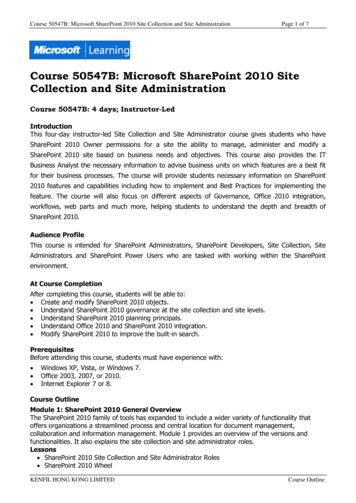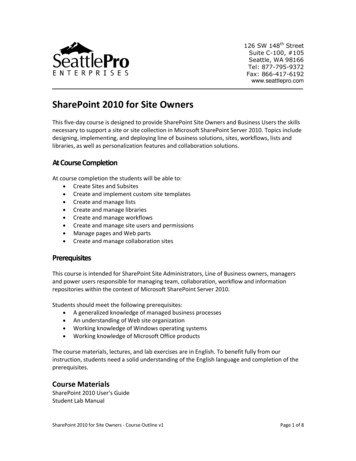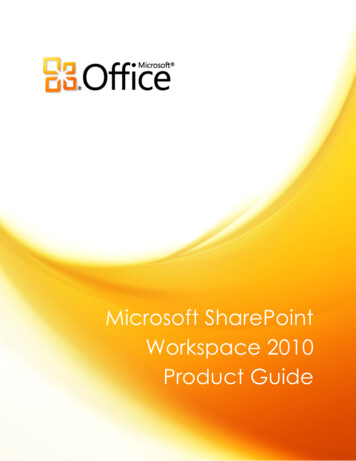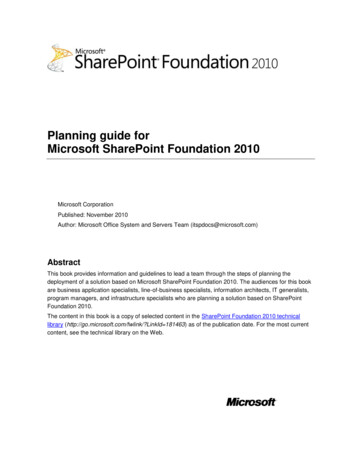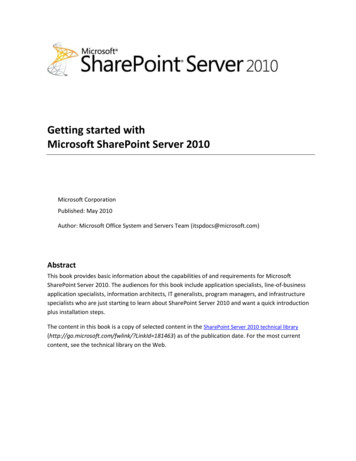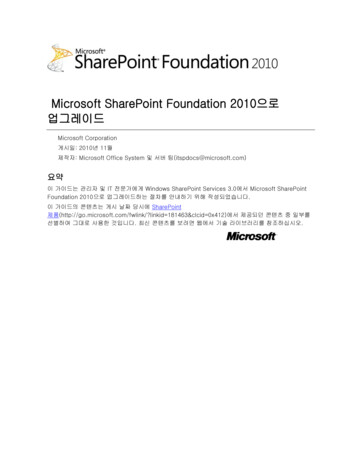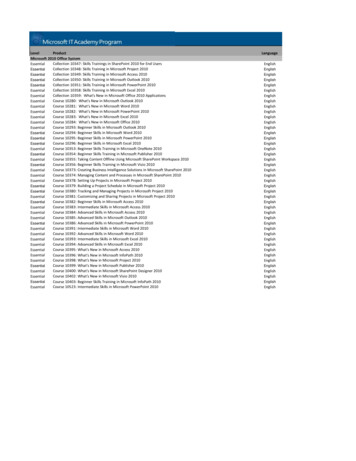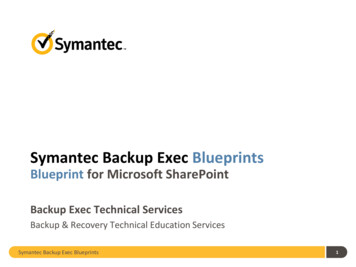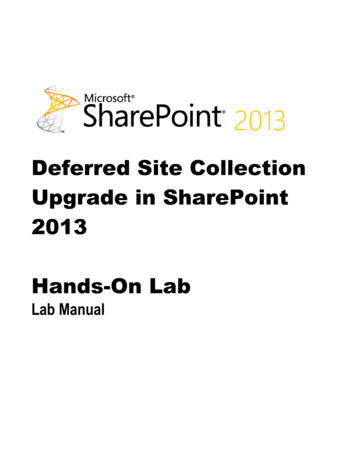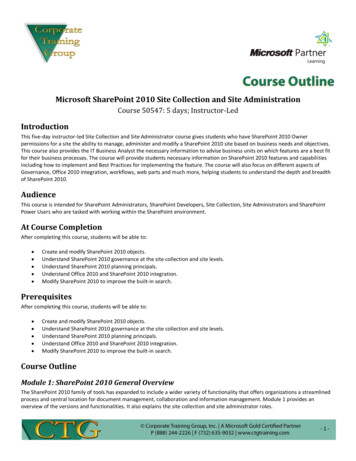
Transcription
Microsoft SharePoint 2010 Site Collection and Site AdministrationCourse 50547: 5 days; Instructor-LedIntroductionThis five-day instructor-led Site Collection and Site Administrator course gives students who have SharePoint 2010 Ownerpermissions for a site the ability to manage, administer and modify a SharePoint 2010 site based on business needs and objectives.This course also provides the IT Business Analyst the necessary information to advise business units on which features are a best fitfor their business processes. The course will provide students necessary information on SharePoint 2010 features and capabilitiesincluding how to implement and Best Practices for implementing the feature. The course will also focus on different aspects ofGovernance, Office 2010 integration, workflows, web parts and much more, helping students to understand the depth and breadthof SharePoint 2010.AudienceThis course is intended for SharePoint Administrators, SharePoint Developers, Site Collection, Site Administrators and SharePointPower Users who are tasked with working within the SharePoint environment.At Course CompletionAfter completing this course, students will be able to: Create and modify SharePoint 2010 objects.Understand SharePoint 2010 governance at the site collection and site levels.Understand SharePoint 2010 planning principals.Understand Office 2010 and SharePoint 2010 integration.Modify SharePoint 2010 to improve the built-in search.PrerequisitesAfter completing this course, students will be able to: Create and modify SharePoint 2010 objects.Understand SharePoint 2010 governance at the site collection and site levels.Understand SharePoint 2010 planning principals.Understand Office 2010 and SharePoint 2010 integration.Modify SharePoint 2010 to improve the built-in search.Course OutlineModule 1: SharePoint 2010 General OverviewThe SharePoint 2010 family of tools has expanded to include a wider variety of functionality that offers organizations a streamlinedprocess and central location for document management, collaboration and information management. Module 1 provides anoverview of the versions and functionalities. It also explains the site collection and site administrator roles.-1-
Lessons SharePoint 2010 Site Collection and Site Administrator RolesSharePoint 2010 WheelComparing SharePoint 2010 VersionsExpanded Browser CapabilitiesAfter completing this module, students will be able to: Understand the role of the SharePoint 2010 Site Collection and Site Administrator.Understand the SharePoint 2010 Wheel.Understand the differences between SharePoint Foundations 2010 and SharePoint 2010.Understand the expanded browser capabilities.Module 2: SharePoint 2010 Environment – Getting StartedThis module will cover basic information for Site Collection and Site Administrators. Having a basic set of terminology and getting the“lay of the land” will help to understand the rest of the course.Lessons SharePoint 2010 EnvironmentNavigationSharePoint 2010 RibbonAdding and Editing Content in SharePoint 2010Using Your Name MenuAfter completing this module, students will be able to: Understand SharePoint 2010 Terminology and the Environment.Navigate around SharePoint 2010.Be able to use the SharePoint 2010 Ribbon.Be able to add and edit basic content within SharePoint 2010.Use the Your Name Menu.Module 3: Organization and Development of SharePoint 2010 SitesFor organizations that are implementing or continuing to improve SharePoint 2010, the majority of the work is not found in the dayto-day activities of creating and managing SharePoint 2010 objects. It falls within the realm of governance and establishing bestpractices for how SharePoint 2010 is used within the organization. Without establishing these principals within the organization,SharePoint 2010 will fail.-2-
Lessons Governance and Best PracticesInformation ArchitectureSite StructureUser EducationResourcesAfter completing this module, students will be able to: Understand Governance and Best Practices within SharePoint 2010.Understand Information Architecture.Understand how site structure can help within SharePoint 2010.Understand how user education can help with SharePoint 2010.Module 4: Site Collections, Top Level Sites and SitesThe first major milestone after Governance is the creation of sites within a site collection. Understanding the types of sites availablewithin SharePoint 2010, as well as the process of creating and understanding navigation, is the foundation for site collection and sitemanagers.Lessons Overview of SharePoint 2010 HierarchySharePoint 2010 Site InventoryCreating Sites and SubsitesModifying Site NavigationSpecialty SitesSites and Navigation Best PracticesLab: Site Collections, Top Level Sites and Sites Exercise 1: Create a New Top Level SiteExercise 2: Create New Sub-Sites called New and Current Projects and SalesExercise 3: Configure Navigation between the Learning Lake SiteExercise 4: Create a Records CenterExercise 5: Create a Projects Web Database site for SalesExercise 6: Create and Configure a Visio Process RepositoryExercise 7: Create a Document WorkspaceAfter completing this module, students will be able to: Understand the different types of SharePoint 2010 sites available.Know how to create SharePoint 2010 sites.Know how to modify site navigation.-3-
Module 5: Creating and Modifying Libraries and ListsMost of the administrating within SharePoint 2010 is done at the list or library level. This module will dig deeper into both lists andlibraries and will help organizations determine what works best for a given situation.Lessons Overview of LibrariesCreating a Library in SharePoint 2010Library InventoryOverview of ListsCreating a List in SharePoint 2010List InventoryLibrary and List Best PracticesLab: Creating and Modifying Libraries and Lists Exercise 1: Create a Custom ListExercise 2: Create a New Product SurveyExercise 3: Create a List from ExcelExercise 4: Create a Document LibraryExercise 5: Create an Asset LibraryExercise 6: Create a Wiki Page LibraryAfter completing this module, students will be able to: Understand the purpose of lists and libraries.Understand the differences between the different lists and libraries.Create a list or library using multiple methods.Customize a list form using InfoPath 2010.Module 6: Managing Permissions for Users and GroupsThis module will explain how permissions work within a site collection and the tools within SharePoint 2010 that are used to manageand maintain them. Being able to create and manage permissions within SharePoint 2010 is one of the more crucial elements thatSharePoint 2010 Site Collection and Site Administrators need to know.Lessons Overview of Permissions and Security in SharePoint 2010Permissions within SharePoint 2010Managing Permissions within SharePoint 2010Stop Inheriting PermissionsCreating a New SharePoint 2010 GroupManaging Users and GroupsOther Permissions Management ToolsPermissions Best Practices-4-
Lab: Managing Permissions for Users and Groups Exercise 1: View Permissions of SharePoint 2010 ObjectsExercise 2: Add Users and Groups to SharePoint 2010 ObjectsExercise 3: Create a New Managers Group with Customized PermissionsExercise 4: Stop Inheriting Permissions between SharePoint 2010 ObjectsAfter completing this module, students will be able to: Understand how permissions work within SharePoint 2010.Manage permissions within the site collection and site.Understand the tools for permissions within SharePoint 2010.Module 7: Site/Content Management and CollaborationWhen a new site is created, the site administrators will need to decide how content is managed within the site. They will also needto consider how sites flow between each other, how information is portrayed, especially at the Welcome Page level, and howcontent is managed within the site.Lessons Overview of Site and Content ManagementContent ManagementRecords Management with the Records CenterSetting up Alerts and Real Simple SyndicationTargeting Audiences with ContentSite and Content Management Best PracticesLab: Site and Content Management Exercise 1: Modify the Current Welcome PageExercise 2: Enable Content ManagementExercise 3: Enable Content RatingExercise 4: Working with Records CenterExercise 5: Enabling and Configuring Audience TargetingAfter completing this module, students will be able to: Understand the concept of Site and Content Management.Implement aspects of Site and Content Management.Understand and implement Records Management through Records Center.Setup Alerts and Real Simple Syndication feeds.Implement Targeting Information for Users.-5-
Module 8: Office 2010 Integration with SharePoint 2010The heavy integration of Microsoft Office 2010 is one of the main benefits of using SharePoint 2010. There are a myriad of ways toconnect SharePoint 2010 to Microsoft Office 2010, whether it is connecting a SharePoint 2010 document library to MicrosoftOutlook, linking an Access database or an Excel spreadsheet to a list in SharePoint 2010, using Microsoft InfoPath to build SharePoint2010 lists, publishing a Visio diagram to be displayed in the web, or managing Microsoft PowerPoint slides in a SharePoint 2010 slidelibrary.Since a majority of SharePoint 2010 users work out of Outlook most of the day, this integration with SharePoint 2010 helps to focusactivities in one or two locations instead of four or five locations. All of these options provide significant improvements over usingthe products on their own. This module will cover the different ways in which SharePoint 2010 and the Office 2010 Suite worktogether to expose the full functionality of the products.Lessons Overview of Office 2010 and Office Web AppCollaborating Using Outlook 2010Connecting and Collaborating with Office 2010 BackstageConnecting, Managing and Editing DocumentsCollaborating with PowerPoint 2010Take Information Offline with SharePoint Workspace 2010Integration of Visio 2010Integration of Access 2010Using InfoPath 2010 with SharePoint 2010Office 2010 Integration Best PracticesLab: Office 2010 Integration with SharePoint 2010 Exercise 1: Connect Outlook 2010 with SharePoint 2010Exercise 2: Collaborate with PowerPoint 2010Exercise 3: Connect Visio 2010 to Visio Process RepositoryExercise 4: Working with Information Offline with Workspace 2010After completing this module, students will be able to: Understand the integration features between Office 2010 and SharePoint 2010.Understand how Office Web Apps works between the two products.Understand the collaboration features available with Outlook 2010.Understand how Excel and Word interact with SharePoint 2010.Understand how PowerPoint can expand collaboration and presentations.Understand how SharePoint 2010 can be taken offline with Workspace 2010.Understand the integration of Visio and Access with SharePoint 2010.Have a basic understanding of how InfoPath 2010 works with SharePoint 2010.-6-
Module 9: Creating Consistency Across SitesWhen developing SharePoint 2010, it is necessary to create a consistent feel across sites within the site collection. This objective fitsin to the Governance aspects of Module 3: Organization and Development of SharePoint 2010 Sites.Lessons Site ColumnsSite Content TypesImplementing Document SetsShow/Hide the Server RibbonSharePoint Site ThemesOverview of SharePoint TemplatesManaging Through Site TemplatesManaging Through List and Library TemplatesPage Layout and Site Template SettingsConsistency Best PracticesLab: Creating Consistency Across Sites Exercise 1: Modify the SharePoint 2010 Site ThemeExercise 2: Create a Site Content TypeExercise 3: Create Document Set for Learning LakeExercise 4: Create a Site TemplateExercise 5: Create a List and Libraries TemplateExercise 6: Designate a Specific Page Layout and Site TemplatesAfter completing this module, students will be able to: Understand and use Site Content Types and Columns.Understand and Implement Document Sets.Implement and Customize SharePoint Site Themes.Module 10: Finding Information Using Search and ViewsOne common complaint within organizations is the difficulty finding documents in a timely manner. Many hours are wastedsearching for a specific document. This module will show methods for searching and configuring views in order to assist SharePoint2010 users in finding what they need in much less time.-7-
LessonsOverview of ViewsAdding Columns to Lists and LibrariesCreating Views in Lists and LibrariesConfiguring Per-Location ViewOverview of Metadata and Taxonomy for SharePoint 2010Implementing Managed MetadataOverview of SearchImplementing Managed Keywords and Best BetsUsing SharePoint SearchConfiguring Search ScopeConfiguring Search VisibilityView and Search Best PracticesLab: Finding Information Using Search and Views Exercise 1: Use Sorting and Grouping to Modify a ViewExercise 2: Create a New View for Project DocumentsExercise 3: Create Calendar and Gantt Chart ViewsExercise 4: Create and Implement Managed Keywords and Best BetsExercise 5: Optimize Project Documents for SearchExercise 6: Test Search to Find InformationAfter completing this module, students will be able to: Understand and configure multiple types of Views.Understand and configure Per-location Views.Understand and implement Metadata within SharePoint 2010.See how Search and Faceted Search work.Configure Search Scopes and Visibility within SharePoint 2010.Module 11: Displaying Data with Web Parts in SharePoint 2010Displaying Data with Web Parts in SharePoint 2010One important feature within SharePoint 2010 is the many different Web Parts. Most of the SharePoint 2010 Web Parts can becustomized. This module will cover the different types of Web Parts that are available and the process of embedding and configuringthem.-8-
Lessons Overview of Web PartsWeb Part InventoryManaging a Web Part on a PageManaging a Web PartCustomizing a Web PartWeb Part MaintenanceWeb Parts Best PracticesLab: Displaying Data with Web Parts in SharePoint 2010 Exercise 1: Create and Modify a Web Part PageExercise 2: Implement and Configure a Link List Web PartExercise 3: Direct Tasks to Individuals using Task List Web PartExercise 4: Implement and Configure a List View Web PartExercise 5: Connect Web Parts to Display InformationExercise 6: Use a Content Query Web PartExercise 7: Display Visio Diagrams using Visio Web AccessExercise 8: Use a Chart Web Part to Display DataAfter completing this module, students will be able to: Understand the different types of Web Parts.Understand how to display Web Parts within a SharePoint 2010 page.Understand basic properties used to configure Web Parts.Understand how to maintain Web Parts.Module 12: Document Management through WorkflowsAn integral part of SharePoint 2010 for document and information management is the ability to configure Workflows. By default,SharePoint 2010 comes with built-in Workflows to help organizations in a variety of different ways, including; approving a new itemor document, collecting feedback from multiple users, or disposing of documents based on compliance policies.Lessons Overview of SharePoint 2010 WorkflowsApproval - SharePoint 2010 WorkflowThree-State WorkflowCollect Feedback - SharePoint 2010 WorkflowCollect Signatures - SharePoint 2010 WorkflowDisposition WorkflowManaging Workflows in SharePoint 2010-9-
Lab: Document Management through SharePoint 2010 Workflows Exercise 1: Create a Workflow to Approve New ProjectsExercise 2: Create a Feedback WorkflowExercise 3: Create a Disposition Approval WorkflowAfter completing this module, students will be able to: Understand Workflows within SharePoint 2010.Implement and Configure the Approval – SharePoint 2010 Workflow.Implement and Configure the Three-State Workflow.Implement and Configure the Collect Feedback – SharePoint 2010 Workflow.Implement and Configure the Collect Signatures – SharePoint 2010 Workflow.Implement and Configure the Disposition Workflow.Understand how to Manage Workflows after created.Module 13: SharePoint 2010 Social Computing and CollaborationAn important advancement within SharePoint 2010 is the inclusion of Social Computing concepts. Many organizations have similarchallenges when working with internal talent management, also known as knowledge management. One common challenge isfinding an individual with the specific skills and knowledge needed to complete a task or project. SharePoint 2010 offers a viableplatform to help organizations with talent or knowledge management.Lessons Overview of Social ComputingUsing My Sites for Knowledge ManagementConfiguring My ProfileUsing Social Tags and Note BoardsSharePoint 2010 My Site BlogSharePoint 2010 Social Computing Best PracticesAfter completing this module, students will be able to: Understand the different components of SharePoint 2010 My Sites.Understand how to configure SharePoint 2010 My Profile.Understand how Social Tags and Note Boards are integrated into SharePoint 2010.Understand how to implement and configure My Site Blogs.Module 14: Administrating a SharePoint 2010 Site Collection and SiteThis module covers SharePoint 2010 topics that Site Collection or Site administrators will work with as part of their day to dayactivities.- 10-
Lessons Overview of Administrating of SharePoint 2010Additional Settings for Site AdministrationAdditional Settings for Site Collection AdministrationAfter completing this module, students will be able to: Understand Governance for Site Administration.Understand additional settings available for Site Administrators.Understand additional settings available for Site Collection Administrators.- 11-
This five-day instructor-led Site Collection and Site Administrator course gives students who have SharePoint 2010 Owner permissions for a site the ability to manage, administer and modify a SharePoint 2010 site based on business needs and objectives. . The SharePoint 2010 family of tools has expanded to include a wider variety of .
